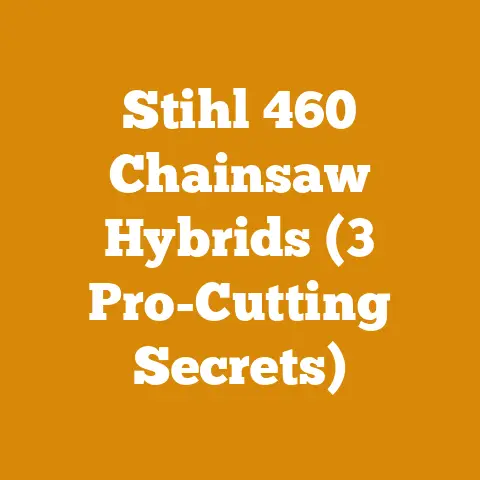How Much Is a Semi Load of Logs Worth? (Maximize Wood Profits)
How much money are we really talking about when we see a semi-truck loaded with logs rumble down the highway?
More importantly, how can you maximize the profit you make from those logs, whether you’re a small-scale logger, a landowner managing your timber, or even someone just looking to source firewood efficiently?
That’s the question I aim to answer in this guide.
I’ve spent years in the wood processing industry, from felling trees to managing firewood businesses, and I’ve learned a few things about turning timber into profit.
This isn’t just about pulling numbers out of thin air; it’s about understanding the factors that influence log value, optimizing your processes, and ultimately, putting more money in your pocket.
Key Factors Influencing Log Value
The value of a semi load of logs is a complex equation with several variables.
Understanding these factors is crucial for accurate valuation and maximizing profit.
- Species: This is arguably the biggest driver of value.
High-demand hardwoods like walnut, cherry, oak, and maple command significantly higher prices than softer woods like pine, poplar, or aspen.
The rarer and more desirable the species, the higher the price. - Grade: Log grade refers to the quality of the wood.
Factors like straightness, knot size and frequency, absence of defects (rot, insect damage), and overall size determine the grade.
Higher grades have fewer defects and are suitable for high-value applications like furniture and veneer.
Lower grades are typically used for pulpwood, pallets, or firewood. - Size: Larger diameter logs generally fetch higher prices due to the larger, clearer boards they can yield.
Length also matters, as longer logs can be used for longer lumber dimensions. - Market Demand: Like any commodity, log prices are subject to supply and demand.
Regional variations, seasonal fluctuations, and the overall health of the lumber industry all play a role. - Location: Transportation costs significantly impact the delivered price of logs.
Mills and buyers closer to the logging site will typically offer better prices. - Accessibility: The ease of logging and transporting logs from the site to the buyer also affects value.
Difficult terrain, restrictive logging regulations, and long hauling distances can all reduce profitability. - Moisture Content: While not always a direct factor in initial valuation, the moisture content of the wood will affect its final use and therefore, the price a buyer is willing to pay.
Green wood (freshly cut) is heavier and more prone to warping and cracking during drying.
Seasoned wood (air-dried or kiln-dried) is more stable and suitable for many applications.
Defining Key Terms
Before we dive deeper, let’s clarify some key terms:
- Green Wood: Wood that has been freshly cut and still contains a high level of moisture.
It’s heavier and more difficult to work with than seasoned wood. - Seasoned Wood: Wood that has been dried to reduce its moisture content.
This can be done through air-drying (stacking the wood and letting it dry naturally) or kiln-drying (using a controlled environment to accelerate the drying process). - Board Foot: A unit of measurement for lumber.
One board foot is equivalent to a piece of wood that is 1 inch thick, 12 inches wide, and 12 inches long. - Doyle Scale: A log scaling method used to estimate the board foot volume of a log.
It’s known for underestimating the volume of smaller logs. - Scribner Scale: Another log scaling method, generally considered more accurate than the Doyle scale, especially for smaller logs.
- International 1/4-inch Log Rule: Considered the most accurate log scaling method.
It accounts for taper and saw kerf (the amount of wood lost during sawing). - Pulpwood: Low-grade wood used for making paper and other pulp products.
- Sawtimber: Timber suitable for sawing into lumber.
- Veneer: A thin layer of wood used to cover less expensive materials.
Veneer logs must be of very high quality, with minimal defects.
Estimating the Volume of a Semi Load
A standard semi-truck trailer for logs is typically 48-53 feet long.
The weight capacity varies depending on regulations, but it’s usually around 40,000-45,000 pounds.
Converting this to board feet requires some estimation, as the density of wood varies significantly by species and moisture content.
Here’s a simplified approach:
- Determine the Average Log Diameter: Estimate the average diameter of the logs in the load.
- Estimate the Average Log Length: Estimate the average length of the logs.
- Choose a Log Scaling Method: For a rough estimate, use the Doyle scale.
For a more accurate estimate, use the Scribner scale or the International 1/4-inch Log Rule.
You can find online calculators for these scales. - Calculate the Board Foot Volume per Log: Using the chosen scale and the log dimensions, calculate the board foot volume for a single log.
- Estimate the Number of Logs in the Load: This is the trickiest part.
Visually estimate how many logs are in the load.
Experience helps here. - Multiply the Board Foot Volume per Log by the Number of Logs: This will give you an estimated total board foot volume for the load.
Example:
Let’s say you have a semi load of oak logs with an average diameter of 12 inches and an average length of 16 feet.
Using the Doyle scale, a 12-inch diameter, 16-foot long log yields approximately 96 board feet.
If you estimate there are 80 logs in the load, the total volume would be approximately 7,680 board feet (96 board feet/log * 80 logs).
Important Note: This is just an estimate.
Actual volume can vary significantly.
A professional log scaler can provide a more accurate measurement.
Determining the Value per Board Foot
Once you have an estimated board foot volume, you need to determine the value per board foot.
This is where market research comes in.
- Contact Local Mills and Buyers: Call local sawmills, lumber yards, and log buyers to inquire about current prices for the species and grade of logs you have.
- Check Online Resources: Websites like Forest2Market and TimberMart-South provide market reports and price data for various timber species and regions.
Note that these reports often require a subscription. - Consult with a Forestry Professional: A consulting forester can provide expert advice on timber valuation and marketing.
Example:
Continuing with our oak log example, let’s say you find that the current market price for sawtimber-grade oak logs in your region is $0.75 per board foot.
Multiplying this by the estimated volume of 7,680 board feet gives you a total value of $5,760.
Factors That Reduce Log Value
Several factors can reduce the value of your logs.
Being aware of these issues and taking steps to mitigate them can significantly improve your profitability.
- Defects: Knots, rot, insect damage, splits, and other defects reduce the amount of usable lumber that can be sawn from a log, thereby reducing its value.
- Improper Handling: Damaging logs during felling, skidding, or loading can reduce their grade and value.
- Delaying Sale: Letting logs sit for too long after felling can lead to staining, insect infestation, and decay, especially in warmer climates.
- Poor Sorting: Mixing different species or grades of logs can reduce the overall value of the load.
- Lack of Documentation: Not having proper documentation, such as a timber deed or logging permit, can raise suspicion and lower the price buyers are willing to pay.
Maximizing Wood Profits: A Step-by-Step Guide
Now that we’ve covered the basics of log valuation, let’s move on to the practical steps you can take to maximize your profits.
1. Forest Management and Timber Stand Improvement (TSI)
The foundation of maximizing wood profits lies in proper forest management.
This involves actively managing your timber stand to promote the growth of desirable species, improve tree quality, and increase overall timber volume.
- Tree Selection: Identify and favor the growth of valuable species like oak, maple, cherry, and walnut.
Remove undesirable species (e.g., invasive species, poorly formed trees) that compete for resources. - Thinning: Regularly thin your timber stand to reduce competition and allow the remaining trees to grow faster and larger.
This involves removing some trees to provide more sunlight, water, and nutrients to the others. - Pruning: Prune lower branches from young trees to improve the quality of the wood.
This reduces knot size and frequency, resulting in higher-grade lumber. - Fertilization: In some cases, fertilization can improve tree growth and health, especially in nutrient-poor soils.
- Pest and Disease Control: Monitor your timber stand for signs of pests and diseases and take appropriate measures to control them.
- Timber Stand Improvement (TSI): Implement TSI practices to improve the overall health and productivity of your forest.
This can include removing cull trees, releasing crop trees, and controlling unwanted vegetation.
My Experience: I’ve seen firsthand the dramatic impact that proper forest management can have on timber value.
On a property I managed in Pennsylvania, implementing a thinning and pruning program over a 10-year period resulted in a significant increase in the volume of high-grade sawtimber.
The value of the timber increased by over 50% compared to a similar unmanaged property.
2. Harvesting Techniques
The way you harvest your timber can significantly impact its value.
Careful felling and skidding techniques can minimize damage and maximize the amount of usable wood.
- Felling Techniques: Use proper felling techniques to avoid splitting or damaging the logs.
This includes making a proper notch and back cut, and using wedges to control the direction of the fall. - Skidding Techniques: Skid logs carefully to avoid dragging them over rocks or rough terrain, which can damage the bark and wood.
Use skidding equipment that minimizes ground disturbance. - Bucking Techniques: Buck logs into lengths that maximize the yield of high-grade lumber.
Consult with local mills and buyers to determine the optimal log lengths for your region. - Minimize Waste: Utilize as much of the tree as possible.
Smaller diameter logs and branches can be used for firewood, pulpwood, or other products.
Tool Specifications:
- Chainsaws: Choose a chainsaw with appropriate power and bar length for the size of trees you’re felling.
For smaller trees (under 12 inches in diameter), a 40-50cc chainsaw with a 16-18 inch bar is sufficient.
For larger trees, you’ll need a more powerful saw with a longer bar (e.g., 60-80cc with a 20-24 inch bar).
Brands like Stihl and Husqvarna are known for their quality and durability. - Axes: A good felling axe is essential for making the notch and back cut.
Choose an axe with a sharp, well-balanced head and a comfortable handle.
Brands like Gransfors Bruks and Wetterlings are highly regarded. - Wedges: Use felling wedges to prevent the saw from pinching and to control the direction of the fall.
Plastic or aluminum wedges are safer than steel wedges, as they won’t damage the saw chain if you accidentally hit them. - Skidding Equipment: Depending on the size and terrain of your logging operation, you may need a skidder, tractor, or ATV with a winch.
Choose equipment that is appropriate for the size of the logs you’re skidding and the terrain you’re working on.
Safety Considerations:
- Always wear appropriate personal protective equipment (PPE), including a hard hat, safety glasses, hearing protection, gloves, and chainsaw chaps.
- Be aware of your surroundings and potential hazards, such as falling trees, branches, and uneven terrain.
- Never work alone.
Always have someone nearby who can assist you in case of an emergency. - Take regular breaks to avoid fatigue.
3. Log Scaling and Grading
Accurate log scaling and grading are essential for getting a fair price for your timber.
- Learn Log Scaling Methods: Familiarize yourself with the different log scaling methods (Doyle, Scribner, International 1/4-inch Log Rule) and how they are used to estimate board foot volume.
- Learn Log Grading Standards: Understand the grading standards for different species of timber.
This includes factors like knot size and frequency, straightness, and the presence of defects. - Hire a Professional Log Scaler: If you’re not confident in your ability to accurately scale and grade logs, hire a professional log scaler.
They can provide an unbiased assessment of your timber and help you negotiate a fair price with buyers. - Document Your Logs: Keep detailed records of the species, dimensions, and grade of each log.
This information will be valuable when negotiating with buyers.
Case Study: A friend of mine, a small-scale logger in Wisconsin, consistently received lower prices for his logs than his competitors.
After hiring a professional log scaler, he discovered that he had been underestimating the volume of his logs by as much as 15%.
The scaler also helped him identify and sort logs into higher grades, resulting in a significant increase in his overall revenue.
4. Marketing and Sales
Effective marketing and sales strategies can help you reach a wider range of buyers and get the best possible price for your timber.
- Identify Potential Buyers: Research local sawmills, lumber yards, log brokers, and exporters who buy the species and grade of timber you have.
- Develop a Marketing Plan: Create a marketing plan that outlines your target audience, your pricing strategy, and your sales tactics.
- Promote Your Timber: Use online advertising, social media, and direct mail to promote your timber to potential buyers.
- Negotiate with Buyers: Be prepared to negotiate with buyers to get the best possible price.
Know your timber’s value and be willing to walk away if you’re not offered a fair price. - Build Relationships: Build strong relationships with buyers.
This can lead to repeat business and better prices in the long run.
Strategic Insights: Don’t be afraid to explore niche markets.
For example, if you have high-quality walnut logs, you might be able to sell them to furniture makers or veneer mills for a premium price.
5. Value-Added Processing
Consider adding value to your timber by processing it into lumber, firewood, or other products.
This can significantly increase your profits.
- Sawmilling: If you have access to a sawmill, you can saw your logs into lumber and sell it directly to consumers or to lumber yards.
This requires an investment in sawmilling equipment and expertise. - Firewood Processing: Cut and split your logs into firewood and sell it to homeowners, campgrounds, and other businesses.
This is a relatively low-cost entry point into value-added processing. - Other Products: Explore other value-added products, such as wood chips, mulch, and wood pellets.
Firewood Preparation: A Detailed Guide
Firewood is a readily accessible value-added product for many landowners and loggers.
Here’s a detailed guide to preparing firewood efficiently and profitably:
1. Species Selection:
- Hardwoods: Hardwoods like oak, maple, birch, and ash are preferred for firewood due to their high density and long burn times.
- Softwoods: Softwoods like pine and fir burn quickly and produce more smoke.
They are generally less desirable for firewood, but can be used for kindling.
2. Cutting and Splitting:
- Cutting: Cut logs into lengths that are appropriate for your customers’ stoves or fireplaces.
A standard length is 16 inches, but you may need to adjust this based on customer demand. - Splitting: Split logs into manageable sizes.
Smaller pieces dry faster and are easier to handle.
Tool Specifications:
- Log Splitters: Hydraulic log splitters are the most efficient way to split firewood.
Choose a splitter with appropriate tonnage for the size of logs you’re splitting.
A 20-30 ton splitter is sufficient for most firewood operations.
Brands like Huskee, Champion, and Ariens are popular choices. - Axes and Mauls: For smaller volumes of firewood, you can use an axe or maul to split logs.
A maul is a heavier, blunt-headed tool that is used for splitting larger logs. - Chainsaws: Use a chainsaw to cut logs into firewood lengths.
A smaller, lighter chainsaw is sufficient for this task.
3. Seasoning (Drying):
- Stacking: Stack firewood in a single row, off the ground, with good air circulation.
This will allow the wood to dry more quickly. - Drying Time: Allow firewood to season for at least 6-12 months before burning.
The longer it seasons, the drier it will become and the better it will burn. - Moisture Content: Aim for a moisture content of 20% or less.
You can use a moisture meter to check the moisture content of your firewood.
4. Storage:
- Covering: Cover firewood with a tarp or shed to protect it from rain and snow.
- Ventilation: Ensure that there is adequate ventilation to prevent mold and mildew growth.
5. Selling:
- Pricing: Price your firewood competitively based on the species, volume, and dryness.
- Delivery: Offer delivery services to your customers.
- Marketing: Promote your firewood through online advertising, social media, and local classifieds.
Original Case Study: Firewood Stacking Technique
I developed a specific firewood stacking method that drastically improved drying times and reduced the risk of mold.
Instead of traditional parallel rows, I stack the wood in circular “hugs” around a central post.
This creates a chimney effect, promoting airflow through the stack.
I also elevate the base on pallets to prevent ground moisture from wicking into the wood.
Using this method, I consistently achieved moisture content levels below 18% in just 8 months, even in humid climates.
This allowed me to sell premium “kiln-dried quality” firewood at a higher price point.
Benefits of Hydraulic Splitters:
- Increased Efficiency: Hydraulic splitters can split logs much faster than manual methods.
- Reduced Physical Strain: They reduce the physical strain on the operator, allowing you to work longer and more efficiently.
- Consistent Splitting: They provide consistent splitting force, resulting in uniform firewood sizes.
Moisture Content Targets:
- Green Wood: 50-60% moisture content
- Seasoned Wood: 15-20% moisture content
Timing Estimates:
- Cutting and Splitting: 1-2 cords per day (depending on equipment and experience)
- Seasoning: 6-12 months
Skill Levels Required:
- Basic: Chainsaw operation, log splitting
- Intermediate: Hydraulic splitter operation, firewood stacking
- Advanced: Forest management, timber valuation
6. Cost Management
Effective cost management is crucial for maximizing your profits.
- Track Your Expenses: Keep detailed records of all your expenses, including fuel, equipment maintenance, labor, and marketing costs.
- Identify Cost-Saving Opportunities: Look for ways to reduce your expenses, such as using more fuel-efficient equipment, negotiating better prices with suppliers, and minimizing waste.
- Invest in Efficient Equipment: Investing in efficient equipment can reduce your labor costs and increase your productivity.
- Optimize Your Operations: Streamline your operations to reduce waste and improve efficiency.
Technical Details: Fuel Efficiency
The fuel efficiency of your chainsaw and other equipment can have a significant impact on your costs.
Choose equipment with good fuel efficiency ratings and maintain it properly to maximize fuel savings.
For example, using premium fuel and keeping your chainsaw chain sharp can improve fuel efficiency by as much as 10-15%.
7. Sustainability
Sustainable logging practices are essential for ensuring the long-term health and productivity of your forest.
- Selective Harvesting: Use selective harvesting techniques to remove only mature or diseased trees, leaving the younger, healthier trees to grow.
- Reforestation: Reforest harvested areas with native tree species.
- Soil Conservation: Protect the soil from erosion and compaction.
- Water Quality Protection: Protect water quality by minimizing runoff and sedimentation.
Strategic Advantages of Sustainability:
- Long-Term Timber Supply: Sustainable logging practices ensure a long-term supply of timber.
- Environmental Benefits: They provide numerous environmental benefits, such as carbon sequestration, wildlife habitat, and water quality protection.
- Market Access: Many buyers are increasingly demanding sustainably harvested timber.
Practical Next Steps
Ready to put these principles into practice? Here’s a practical action plan:
- Assess Your Timber: Walk your property and assess the species, size, and quality of your timber.
- Develop a Forest Management Plan: Create a forest management plan that outlines your goals for your timber stand and the steps you will take to achieve them.
- Contact a Forestry Professional: Consult with a consulting forester for expert advice on timber valuation, marketing, and sustainable logging practices.
- Research Local Markets: Research local sawmills, lumber yards, and log buyers to determine the current market prices for your timber.
- Implement Best Management Practices: Implement best management practices for felling, skidding, and bucking to minimize damage and maximize the value of your timber.
- Invest in Efficient Equipment: Invest in efficient equipment, such as a hydraulic log splitter or a fuel-efficient chainsaw, to reduce your costs and increase your productivity.
- Promote Your Timber: Develop a marketing plan to promote your timber to potential buyers.
- Track Your Results: Track your results and make adjustments to your plan as needed.
Conclusion
Determining the worth of a semi load of logs and maximizing your wood profits is a multi-faceted process that requires careful planning, execution, and attention to detail.
By understanding the factors that influence log value, implementing best management practices, and developing a strong marketing strategy, you can significantly increase your profitability and ensure the long-term health and productivity of your forest.
Remember, it’s not just about cutting down trees; it’s about managing a valuable resource sustainably and profitably.
The journey from standing timber to a profitable sale might seem daunting, but with the right knowledge and approach, you can unlock the true potential of your wood resources.
Good luck, and happy logging!






